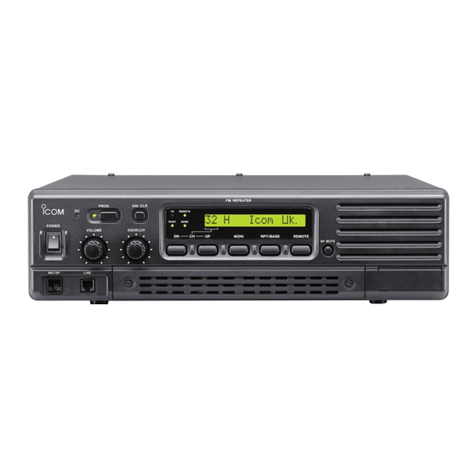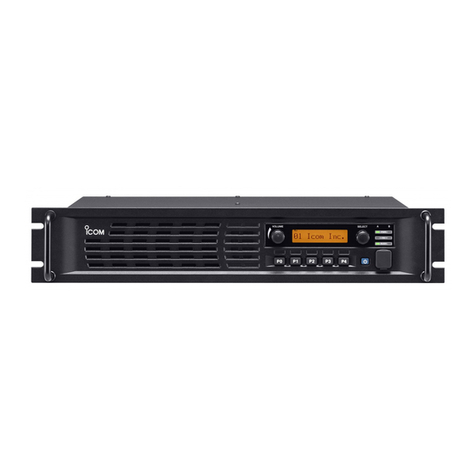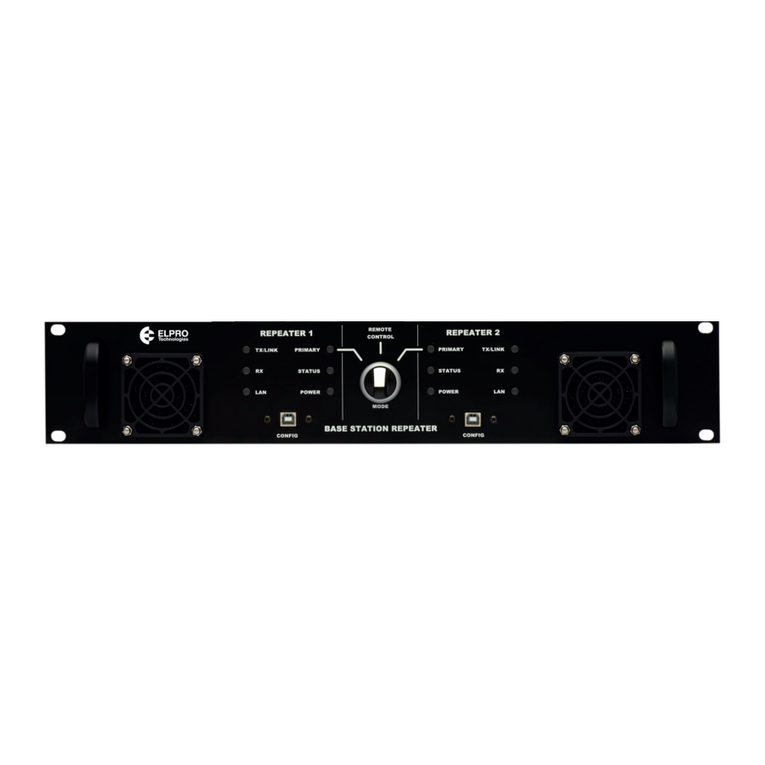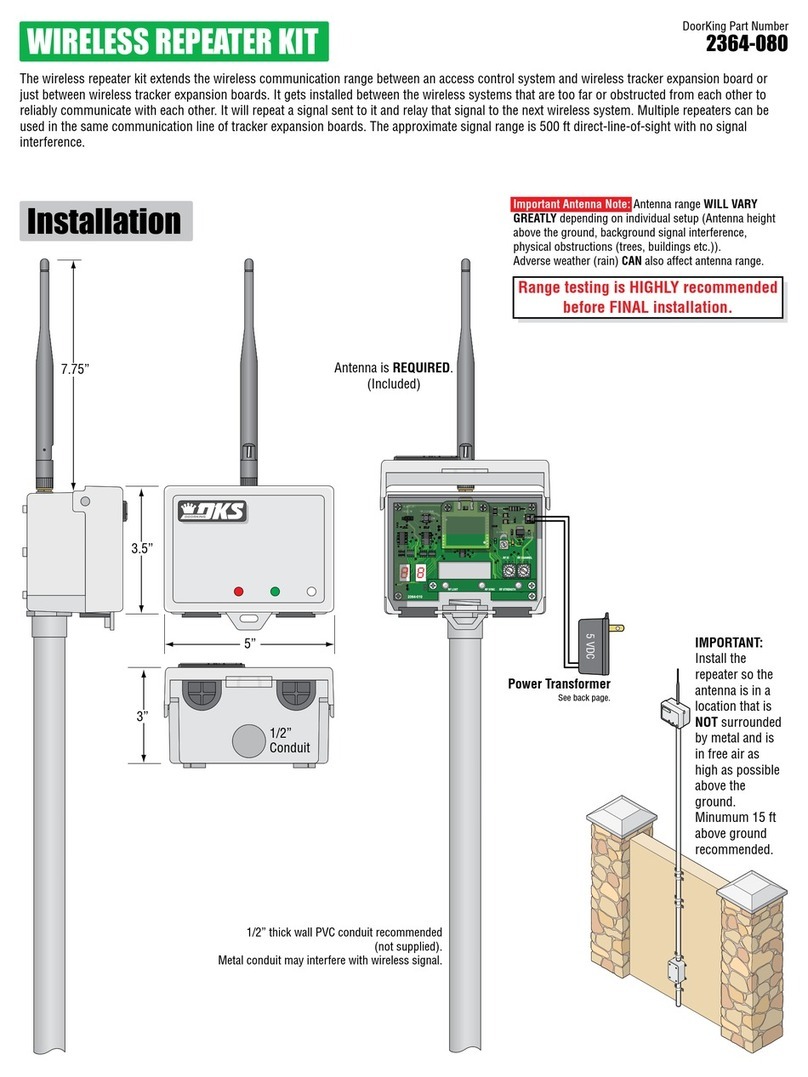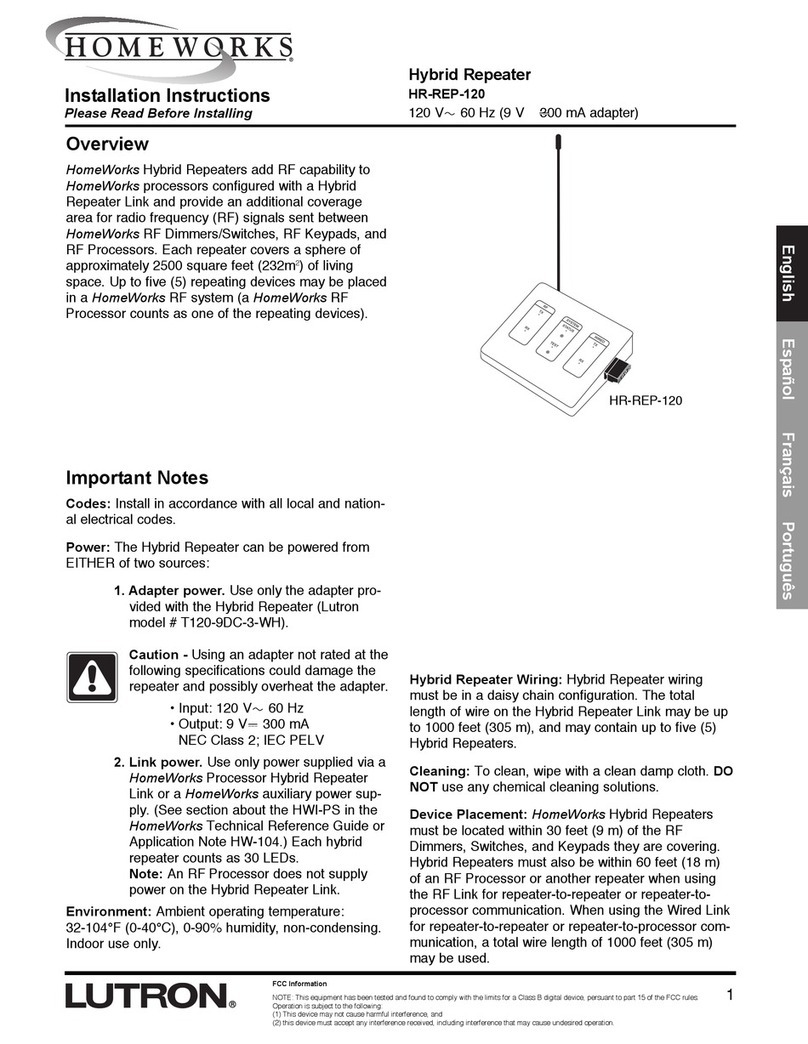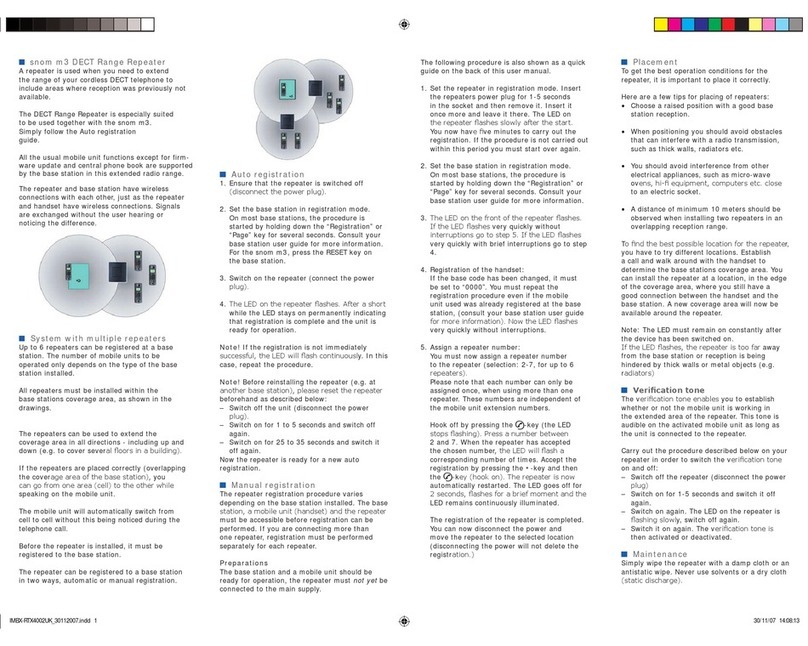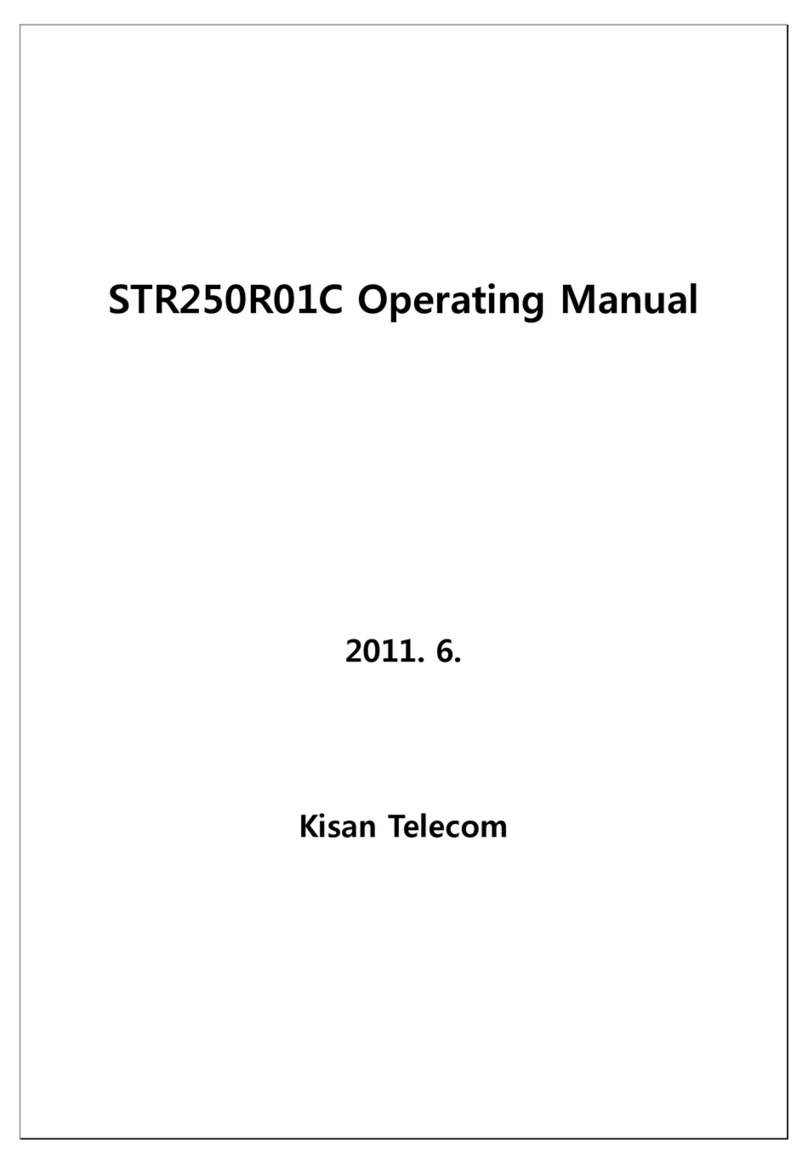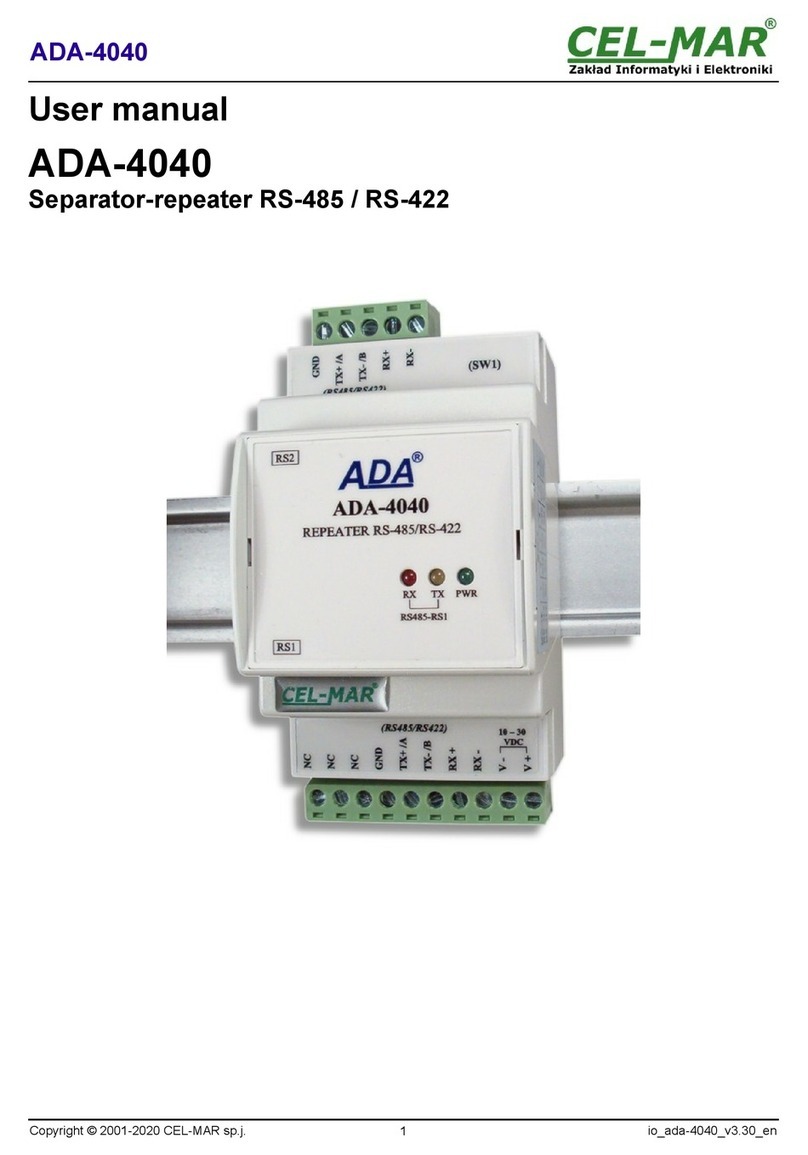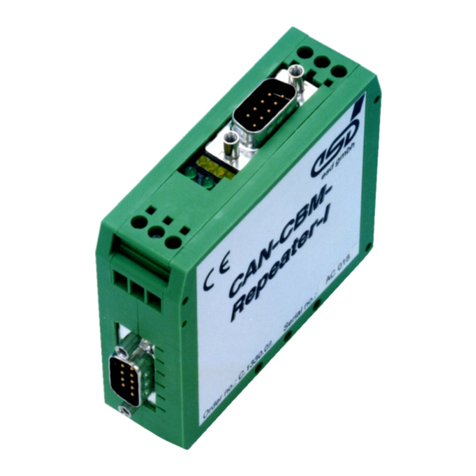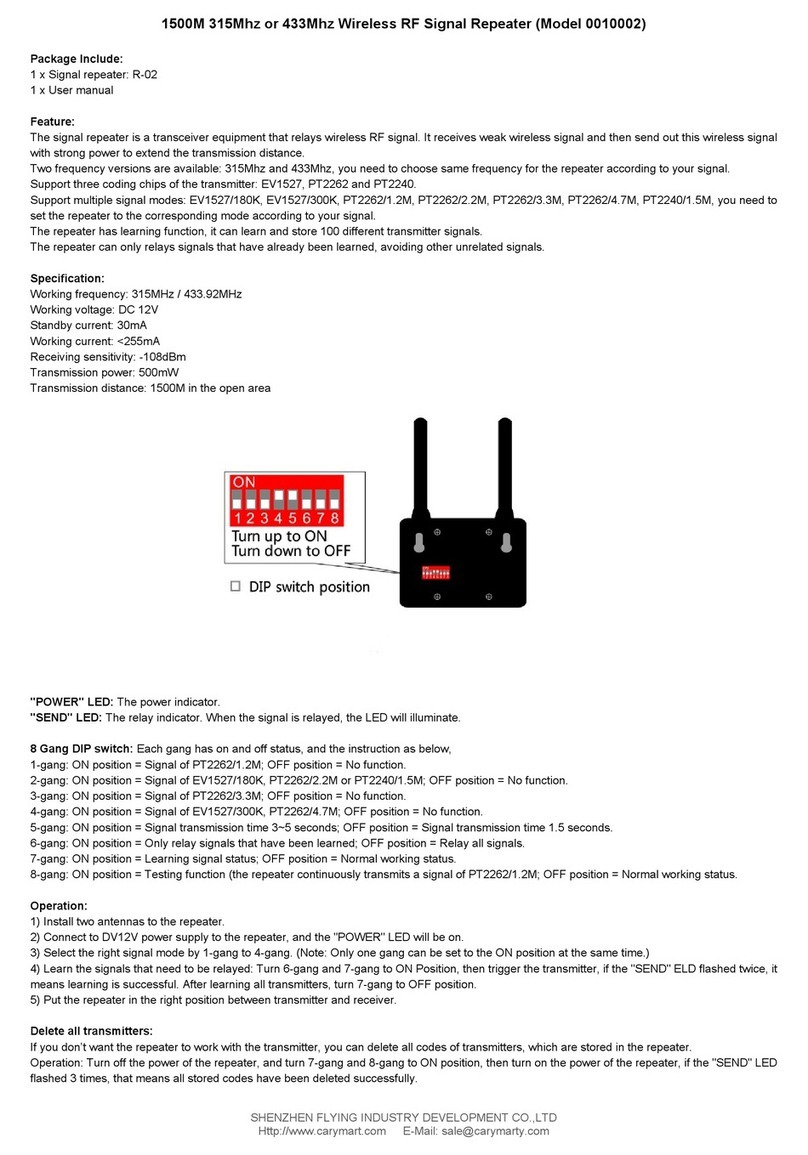Icom IC-FR5100 User manual

INSTRUCTION MANUAL
iFR6100
UHF dPMR REPEATER
iFR6100H
iFR5100
VHF dPMR REPEATER
iFR5100H

i
IMPORTANT
READ THIS INSTRUCTION MANUAL
CAREFULLY before attempting to operate the re-
peater.
SAVE THIS INSTRUCTION MANUAL– This
manual contains important safety and operating in-
structions for the IC-FR5100 and IC-FR5100H vhf
dp m r r e p e at e r s , and the IC-FR6100 and IC-FR6100H
u h f dp m r r e p e at e r s .
FORWARD
Thank you for purchasing this Icom repeater. The IC-
FR5100/H and the IC-FR6100/H are designed and
built with Icom’s state of the art technology and crafts-
manship. With proper care, this product should provide
you with years of trouble-free operation.
We appreciate you making the IC-FR5100/H and
IC-FR6100/H your repeater of choice, and hope you
agree with Icom’s philosophy of “technology first.”
Many hours of research and development went into
the design of your IC-FR5100/H and IC-FR6100/H.
DFEATURES
mUp to 2 channel operation
(IC-FR5100/IC-FR6100 only)
You can install an optional UR-FR5100/UR-FR6100
channel extension module into a repeater. 2 chan-
nels can be utilized when a channel extension
module is installed.
mBuilt-in 5-Tone, DTMF encoder & decoder
Multiple signaling systems are included as stan-
dard. These systems are fully compatible with Icom
F-series radios.
mDTMF remote control capability
You can control the repeater from a remote location
over the air, or over a phone line with DTMF.
mD-Sub 25 pin ACC port equipped
You can use optional equipment connected to
the D-sub 25 pin ACC port on the repeater’s rear
panel.
mOther features
- Wide 136 to 174 MHz, 400 to 470 MHz frequency
coverage
- PC programmable
- 19 inch rack mountable
- Optional UT-109R/UT-110R Voice Scrambler Unit
for base operation
EXPLICIT DEFINITIONS
WORD DEFINITION
RWARNING! Personal injury, fire hazard or electric
shock may occur.
CAUTION Equipment damage may occur.
NOTE
If disregarded, inconvenience only. No
risk of personal injury, fire or electric
shock.
SUPPLIED ACCESSORIES
The following accessories are supplied.
Handles For handle attachment
Spacers Screws
Coaxial cable
(OPC-2243)*
1
DC power cable*
2
Function name stickers*
3
KEY SEAL
COUNTRY CODE LIST
Country Codes Country Codes
1
2
3
4
5
6
7
8
9
10
11
12
13
14
15
16
17
Austria
Belgium
Bulgaria
Croatia
Czech Republic
Cyprus
Denmark
Estonia
Finland
France
Germany
Greece
Hungary
Iceland
Ireland
Italy
Latvia
AT
BE
BG
HR
CZ
CY
DK
EE
FI
FR
DE
GR
HU
IS
IE
IT
LV
18
19
20
21
22
23
24
25
26
27
28
29
30
31
32
33
Liechtenstein
Lithuania
Luxembourg
Malta
Netherlands
Norway
Poland
Portugal
Romania
Slovakia
Slovenia
Spain
Sweden
Switzerland
Turkey
United Kingdom
LI
LT
LU
MT
NL
NO
PL
PT
RO
SK
SI
ES
SE
CH
TR
GB
*1This item is supplied only with the
high power versions.
*2Two DC power cables are supplied
with the high power versions.
*3Used for labelling the programmable
function keys according to their
assinged functions.

ii
PRECAUTIONS
RWARNING HIGH VOLTAGE! NEVER attach
an antenna or internal antenna connector while trans-
mitting. This may result in an electrical shock or burn.
RWARNING HIGH VOLTAGE! NEVER install
the antenna in a place where a person could easily
touch the antenna while transmitting. This could result
in an electrical shock or burn.
RWARNING! NEVER apply AC to the DC power
receptacle on the repeater rear panel. This could
cause a fire or damage the repeater.
RWARNING! NEVER apply more than 16 V DC,
such as a 24 V battery, to the DC power receptacle
on the repeater rear panel. This could cause a fire or
damage the repeater.
CAUTION: NEVER let metal, wire or other objects
touch any internal part or connectors on the rear panel
of the repeater. This may result in an electric shock.
CAUTION: NEVER expose the repeater to rain,
snow or any liquids.
DO NOT use or place the repeater in areas with tem-
peratures below –25°C or above +55°C. Be aware that
temperatures can exceed +80°C, resulting in perma-
nent damage to the repeater if left there for extended
periods.
DO NOT place the repeater in excessively dusty en-
vironments or in direct sunlight.
DO NOT put anything on top of the repeater. This will
obstruct heat dissipation.
Place the repeater in a secure place to avoid inadver-
tent use by children.
BE CAREFUL: The heatsink will become hot when
operating the repeater continuously for long periods.
BE CAREFUL: If a linear amplifier is connected,
set the repeater’s RF output power to less than the
linear amplifier’s maximum input level, otherwise, the
linear amplifier will be damaged.
USE only the specified microphone. Other micro-
phones have different pin assignments and may dam-
age the repeater.
Place the repeater in a secure place to avoid inadver-
tent access by children.
VOICE CODING TECHNOLOGY
The AMBE+2™ voice coding Technology embodied in this
product is protected by intellectual property rights including
patent rights, copyrights and trade secrets of Digital Voice
Systems, Inc. This voice coding Technology is licensed
solely for use within this Communications Equipment. The
user of this Technology is explicitly prohibited from attempt-
ing to extract, remove, decompile, reverse engineer, or
disassemble the Object Code, or in any other way convert
the Object Code into a human-readable form. U.S. Patent
Nos. #5,870,405, #5,826,222, #5,754,974, #5,701,390,
#5,715,365, #5,649,050, #5,630,011, #5,581,656,
#5,517,511, #5,491,772, #5,247,579, #5,226,084 and
#5,195,166.
TABLE OF CONTENTS
Icom, Icom Inc. and the Icom logo are registered trademarks
of Icom Incorporated (Japan) in Japan, the United States,
the United Kingdom, Germany, France, Spain, Russia and/or
other countries.
1
2
3
4
5
6
7
8
9
10
11
12
13
14
15
16
17
18
19
20
21
IMPORTANT............................................................... i
FORWARD ................................................................. i
EXPLICIT DEFINITIONS............................................ i
SUPPLIED ACCESSORIES....................................... i
COUNTRY CODE LIST.............................................. i
PRECAUTIONS......................................................... ii
VOICE CODING TECHNOLOGY .............................. ii
TABLE OF CONTENTS ............................................ ii
1 PANEL DESCRIPTION..................................... 1–4
■ Front panel ........................................................ 1
DFunction display ............................................ 2
■ Rear panel......................................................... 2
DAccessory connector .................................... 3
DI/O connector (for the PA unit)....................... 4
2 INSTALLATION AND CONNECTIONS............ 5–7
■ Unpacking ......................................................... 5
■ Selecting a location ........................................... 5
■ Grounding ......................................................... 5
■ Antenna connection .......................................... 5
■ Front panel connection...................................... 6
■ Rear panel connection—
For the IC-FR5100H/IC-FR6100H..................... 6
■ Rear panel connection—
For the IC-FR5100/IC-FR6100.......................... 7
■ Power supply connection .................................. 7
■ Mounting the repeater ....................................... 7
DUsing the supplied handle............................. 7
3 OPERATION......................................................... 8
■ Receiving and transmitting................................ 8
DRepeater operation ....................................... 8
DBase station operation .................................. 8
4 MAINTENANCE ................................................... 9
■ Troubleshooting ................................................. 9
■ Fuse replacement ............................................. 9
DLine fuse replacement................................... 9
5 OPTIONS............................................................ 10
6 ABOUT CE ................................................... 11–12

1
1
PANEL DESCRIPTION
qINTERNAL SPEAKER
Received audio is heard.
wVOLUME CONTROL [VOLUME] (p. 8)
Adjusts the audio output level.
eSELECTOR DIAL [SELECT]
Rotate to adjust the squelch threshold level, or se-
lect the operating channel, depending on the pre-
programming.
rPOWER INDICATOR [POWER]
➥Lights green on ‘A’ module’s indicator while the
repeater power is ON.
When a channel extension module is installed
(For IC-FR5100/IC-FR6100):
➥Lights green on the selected module indicator,
‘A’ or ‘B,’ while the repeater power is ON.
➥Lights orange on the un-selected module indica-
tor, ‘A’ or ‘B,’ while the repeater power is ON.
tTRANSMIT INDICATOR [TX]
Lights red while transmitting.
yBUSY INDICATOR [BUSY]
Lights green while receiving a signal, or when the
noise squelch is open.
About [PWR], [TX] and [BUSY] indicators
(For IC-FR5100/IC-FR6100):
‘A’ module's indicator corresponds to the original
module, and ‘B’ module's indicator corresponds to
the extended module.
u
MICROPHONE CONNECTOR [MIC]
This 8-pin modular jack accepts an optional micro-
phone.
KEEP the [MIC] connector cover attached to the
repeater when the microphone is not used.
qi
q+8 V DC output (15 mA maximum)
wOutput port for PC programming
eNC
rM PTT (Input port for TX control)
tMicrophone ground
yMicrophone input
uGround
iInput port for PC programming
iPOWER SWITCH [POWER]
➥Push to turn ON the repeater power.
➥Hold down for 3 seconds to turn OFF the re-
peater power.
When a channel extension module is installed
(For IC-FR5100/IC-FR6100):
➥While the repeater power is turned ON, push
to select the desired module to operate the re-
peater as a base station.
•Thepowerindicatoroftheselectedmodule unit
lights green.
oDEALER-PROGRAMMABLE KEYS
Desired functions can be programmed for each key
by your dealer.
Ask your dealer for details.
•Becausethesekeysareprogrammable,theirfunctions
are unique to each unit.
P
0
P
1
P
2
P
3
P
4
qw e
i uo
Function
display
y
t
r
■Front panel

1
2
3
4
5
6
7
8
9
10
11
12
13
14
15
16
17
18
19
20
21
2
1
PANEL DESCRIPTION
q
EXTERNAL SPEAKER JACK [SP]
Connects to the optional external speaker.
wIF SIGNAL OUT CONNECTOR
Connects to a dPMR control unit to output an IF sig-
nal.
eRECEIVE ANTENNA CONNECTOR [RX]
Connects to a 50 ˘antenna to receive.
rACCESSORY CONNECTOR [ACC]
See page 3 for accessory connector information.
(For IC-FR5100/IC-FR6100)
Connects to an external equipment.
(For IC-FR5100H/IC-FR6100H)
Connects to the [I/O] connector on the PA unit and/
or to an external equipment.
tDC POWER RECEPTACLE
Connect the supplied DC power cable from this
connector to an external 13.2 V DC power source.
yTRANSMIT ANTENNA CONNECTOR [TX]
(For IC-FR5100/IC-FR6100)
Connects to a 50 ˘antenna to transmit.
(For IC-FR5100H/IC-FR6100H)
Connects to the [TX] connector on the PA unit
through the supplied coaxial cable (OPC-2243) to
output the repeater’s transmit signal to the PA unit.
uGROUND TERMINAL [GND]
Connect this terminal to ground to prevent electrical
shocks, TVI, BCI and other problems.
iANTENNA CONNECTOR [ANT]
Connects to a 50 ˘antenna to transmit.
oDC POWER RECEPTACLE
Connects the supplied DC power cable from this
connector to an external 13.2 V DC power source.
!0 INPUT/OUTPUT CONNECTOR [I/O]
Connects to the [ACC] connector on the repeater
unit through the optional OPC-2202 or OPC-2203.
•Seepage6fortherepeaterunitconnectiondetails.
!1 RF IN CONNECTOR [TX]
Connects to the [TX] connector on the repeater unit
through the supplied coaxial cable to input the re-
peater’s transmit signal.
er yt iu!1!0o
Repeater unit* PA unit
q
w
q SIGNAL STRENGTH INDICATOR
Indicates the relative signal strength level.
w LOW POWER INDICATOR
Appears when low output power is selected.
e AUDIBLE INDICATOR
Appears when the channel is in the ‘audible’ (un-
mute) mode.
r COMPANDER INDICATOR
Appears when the compander function is activated.
t SCRAMBLER/ENCRYPTION INDICATOR
Appears when the voice scrambler/encryption func-
tion is activated.
y ALPHANUMERIC DISPLAY
Shows a variety of text and code information.
■Rear panel
DFunction display
ICOM Inc.
qwert
y
*For the IC-FR5100/IC-FR6100, the repeater unit is installed in the right side (back view).

3
1PANEL DESCRIPTION
DAccessory connector
q!3
!4 @5
■Rear panel (Continued)
Pin No. Pin Name Description Specification
1 NC No connection —
2 TXD Output terminal for serial communication data. —
3 RXD Input terminal for serial communication data. —
4 RTS Output terminal for request-to-send data. —
5 CTS Input terminal for clear-to-send data. —
6 NC No connection —
7 GND Serial/digital signal ground —
8 MOD IN
Modulator input from an external terminal unit. Input impedance: 2.7 kΩ
Input level: 85 mV rms (for 60% deviation)
NOTE: If the input impedance is changed
to 27 kΩ, a 300 mV rms input level is
needed for 60% deviation signal.
9 DISC OUT
Buffer output terminal for AF signals from the AF detector
circuit. The output level simultaneously changes with the
modulation level of the received signal, regardless of the
[AF] control setting.
Output level: 300 mV rms*2
*2Received 60% deviation signal
10 EXT. D/A The desired function can be assigned.*1—
11 VCC 13.2 V DC output Output current: Less than 1 A
12 EXT. A/D Customize A/D input —
13 NC No connection —
14 GND Ground —
15 EXT. I/O 15 The desired function can be assigned.*1+5 V pull up, Active=L*3
16 EXT. I/O 16 The desired function can be assigned.*1+5 V pull up, Active=L*3
17 EXT. I/O 17 The desired function can be assigned.*1+5 V pull up, Active=L*3
18 EXT. I/O 18 The desired function can be assigned.*1+5 V pull up, Active=L*3
19 EXT. I/O 19 The desired function can be assigned.*1+5 V pull up, Active=L*3
20 DATA IN Input terminal for data.The signals from this terminal bypass
the pre-emphasis circuit.
Input impedance: 47 kΩ
Input level: 300 mV rms (for 60% deviation)
21 EXT. I/O 21 The desired function can be assigned.*1+5 V pull up, Active=L*3
22 AF OUT
Buffer output terminal for AF signals through the de-
emphasis circuit from the AF detector circuit. The output
level simultaneously changes with the modulation level of
the received signal, regardless of the [AF] control setting.
Output level: 300 mV rms*4
*4Received 60% deviation signal
23 EXT. I/O 23 The desired function can be assigned.*1+5 V pull up, Active=L*3
24 EXT. I/O 24 The desired function can be assigned.*1+5 V pull up, Active=L*3
25 EXT. I/O 25 The desired function can be assigned.*1+5 V pull up, Active=L*3
*1The desired function can be assigned using the optional CS-FR5000(dPMR) c l o n i n g s o f t w a r e . Ask your dealer for details.
The default settings are shown to the right.
*3The active logic can be set to High using the optional CS-FR5000(dPMR) c l o n i n g s o f t w a r e . Ask your dealer for details.

1
2
3
4
5
6
7
8
9
10
11
12
13
14
15
16
17
18
19
20
21
4
1
PANEL DESCRIPTION
DI/O connector (for the PA unit)
yo
qt
Pin No. Pin Name Description Specification
1 PA TEMP Output terminal for the PA unit temperature data. —
2 FAN ALM Output terminal for the cooling fan data. H: Normal,
L: Fan stops or decreases to half speed.
3 50 W/100 W Input terminal for the output power selection. H: 50 W, L: 100 W
•Dependingontherepeater’sversion,
the output power is restricted to 50 W.
4 RF ALM Output terminal for the low output power level. H: Normal, L: Low output power
5 PTT Input terminal. When grounded, transmit. H: Standby, L: Transmit
6 NC No connection —
7 GND Connects to the [GND] terminal of the PA unit. —
8 NC No connection —
9 NC No connection —
The list shows the default functions that are assigned to the pins 10, 12, 15, 16, 17, 18, 19, 21, 23, 24 and 25.
Pin No. Pin Name Default
IC-FR5100/IC-FR6100 IC-FR5100H/IC-FR6100H
10 EXT. D/A Null Null
12 EXT. A/D Null UR-PA5000 Temperature Input*
(Connects to Pin 1 of the I/O connector.)
15 EXT. I/O 15 Null External Alert1 Input*
(Connects to Pin 2 of the I/O connector.)
16 EXT. I/O 16 P0 Monitor Output External Alert2 Input*
(Connects to Pin 4 of the I/O connector.)
17 EXT. I/O 17 Busy Output Busy Output
18 EXT. I/O 18 Null TX Output*
(Connects to Pin 5 of the I/O connector.)
19 EXT. I/O 19 EPTT Input EPTT Input
21 EXT. I/O 21
Analog Audible Output 50W/100W Output*
(Connects to Pin 3 of the I/O connector.)
•Dependingontherepeater’sversion,the
output power is restricted to 50 W.
23 EXT. I/O 23 Mic Mute Output Mic Mute Output
24 EXT. I/O 24 Null Alert Output
25 EXT. I/O 25 Mic Hanger Output Mic Hanger Output
*When the PA unit is used, these functions must be assigned to the specified pin. Ask your dealer for details.

2
5
INSTALLATION AND CONNECTIONS
■Unpacking
After unpacking, immediately report any damage to
the delivering carrier or your dealer. Keep the shipping
cartons.
For a description and a diagram of accessory equip-
ment included with the repeater, see ‘SUPPLIED AC-
CESSORIES’ on page i of this manual.
■Selecting a location
Select a location for the repeater that allows adequate
air circulation, free from extreme heat, cold, or vibra-
tions, and away from TV sets, TV antenna elements,
radios and other electromagnetic sources.
■Grounding
To prevent electrical shock, television interference
(TVI), broadcast interference (BCI) and other problems,
ground the transceiver using the GROUND terminal on
the rear panel.
For best results, connect a heavy gauge wire or strap
to a long ground rod. Make the distance between the
[GND] terminal and ground rod as short as possible.
RWARNING! NEVER connect the [GND] terminal
to a gas or electric pipe, since the connection could
cause an explosion or electric shock.
■Antenna connection
For radio communications, the antenna is a critical
component, along with output power and sensitivity.
Select antenna(s) such as a well-matched 50 ˘an-
tenna, and feedline. A Voltage Standing Wave Ratio
(VSWR) of 1.5:1 or better for the desired band is rec-
ommended. Of course, a coaxial cable should be used.
CAUTION: Protect the repeater from lightning by
using a lightning arrestor.
NOTE: There are many publications that describe
proper antennas and their installation. Check with
your local dealer for more information and recom-
mendations.
TYPE-N CONNECTOR INSTALLATION EXAMPLE
Slide the nut, flat washer, rubber gasket and clamp over the coaxial
cable, then cut the end of the cable evenly.
Strip the cable and fold the braid back over the clamp.
Tin the center conductor. Install the center conductor pin and solder it
in place.
Carefully slide the plug body into place, aligning the center conductor
pin on the cable. Tighten the nut onto the plug body.
q
w
e
r
15 mm
3 mm 6 mm
No space
Solder hole
Be sure the center conductor is
the same height as the plug body.
Clamp Center
conductor
Washer
Nut Rubber gasket
[GND]

1
2
3
4
5
6
7
8
9
10
11
12
13
14
15
16
17
18
19
20
21
6
2
INSTALLATION AND CONNECTIONS
■Front panel connection
■Rear panel connection— For the IC-FR5100H/IC-FR6100H
To [TX]
OPC-2202
(Option)
OPC-2243
To [ACC]
To
[I/O]To [TX]
Connects to a dPMR
control unit, if used.
Connects to a 4 ˘
external speaker.
Connects to
an RX antenna. GND
Connects to
a TX antenna
OPC-2203
(Option)
Connects to external
equipment, if used.
OPC-2202
OPC-2203
If external equipment
is used, an OPC-2203
must be connected.
Black
Red
30 A
fuses
DC power supply
AC outlet
AC cable
Supplied
DC power cable
13.2 V; at least 30 A
Black
_
Red
+
CAUTION:
NEVER remove the
fuse holders from the
DC power receptacle.
Black
Red
20 A
fuses
DC power supply
AC outlet
AC cable
Supplied
DC power cable
13.2 V; at least 10 A
Black
_
Red
+
P0P1P2P3P4
SM-26 DESKTOP
MICROPHONE
(optional)
MICROPHONE CONNECTOR (Front panel view)
HM-152 HAND
MICROPHONE
(optional)
qi
CAUTION: DO NOT short pin 1 to ground as this can
damage the internal 8 V regulator. DC voltage is applied
to pin 1 for microphone operation. Only Icom micro-
phones are recommended.
q+8 V DC output (15 mA maximum)
wOutput port for PC programming
eNC
rM PTT (Input port for TX control)
tMicrophone ground
yMicrophone input
uGround
iInput port for PC programming

7
2INSTALLATION AND CONNECTIONS
■Power supply connection
Make sure the repeater’s power is turned OFF when
connecting a DC power cable.
CAUTION: Voltages greater than 16 V DC will dam-
age the repeater. Check the source voltage before
connecting the power cable.
■Mounting the repeater
DUsing the supplied handle
The supplied handles are useful when mounting the
repeater into a 19 inch rack. The handles are installed
on the repeater’s front panel.
qAttach the supplied handles to both sides of the re-
peater’s front panel with the spacers, then tighten
the screws as shown below.
P
0
P
1
P
2
P
3
P
4
Handle
Spacer
Screw
wThe completed installation should look like this.
P
0
P
1
P
2
P
3
P
4
■Rear panel connection— For the IC-FR5100/IC-FR6100
CAUTION: NEVER remove the
fuse holders from the DC power
receptacle.
EXTERNAL SPEAKER
4 ˘external speaker
Connects to a TX antenna
(p. 5)
Connects to an
RX antenna (p. 5)
ACC CONNECTOR
(p. 3)
Used for external
equipment control.
Connects to a dPMR
control unit, if used.
Black
Red
20 A
fuses
DC power supply
AC outlet
AC cable
Supplied
DC power cable
13.2 V; at least 15 A
Black
_
Red
+
RWhen you disconnect the DC power cable, take
care to not break your fingernail.
qPush
w
NOTE: The optional UR-PA5000/UR-PA6000
p o w e r a m p l i f i e r u n i t s can be installed. See
the installation guide that comes with the
UR-PA5000/UR-PA6000 for details.

3
8
OPERATION
1
2
3
4
5
6
7
8
9
10
11
12
13
14
15
16
17
18
19
20
21
■Receiving and transmitting
DRepeater operation
Ask your dealer for details of the repeater’s program-
ming.
➥When the power is turned ON, the [PWR] indicator
lights green. (p. 1)
➥The [TX] and [BUSY] indicators light simultane-
ously while transmitting and receiving a signal.
•The[TX] indicator lights red.
•The[BUSY] indicator lights green.
NOTE: A power amplifier protector is built-in to the
repeater. When the repeater temperature becomes
extremely high due to the frequently access to the
repeater, the protector is activated to reduce the
transmit output power level. The output power will
return to its normal level when the repeater has
cooled down.
DBase station operation
Receiving
qPush [POWER] to turn ON the power.
wSet the audio and squelch levels.
➥Rotate [SELECT]*1fully counterclockwise first.
➥Rotate [VOLUME] to adjust the audio output
level.
➥Rotate [SELECT]*1clockwise until the noise just
disappears.
ePush [CH Up]*2or [CH Down]*2to select the de-
sired channel.
•Whenreceivingasignal,the[BUSY] indicator lights
green and audio is heard from the speaker.
•Furtheradjustmentof[VOLUME] to a comfortable lis-
tening level may be necessary at this point.
*1When the [SQL Level Up/Down] key function is assigned
to [SELECT].
*2When the [CH Up]/[CH Down] key functions are as-
signed.
Transmitting
qTake the microphone off the hook.
wWait for the channel to become clear.
eHold down [PTT] to transmit, then speak into the
microphone at your normal voice level.
rRelease [PTT] to receive.
IMPORTANT:
To maximize the audio quality of the transmitted sig-
nal:
(1) Pause briefly after pushing [PTT] before you begin
speaking.
(2) Hold the microphone 5 to 10 cm (2 to 4 inch) from
your mouth, then speak at a normal voice level.

4
9
MAINTENANCE
■Troubleshooting
The following chart is designed to help correct prob-
lems which are not equipment malfunctions.
If you are unable to locate the cause of a problem or
solve it through the use of this chart, contact the near-
est Icom Dealer or Service Center.
■Fuse replacement
If a fuse blows, and the repeater stops functioning, find
the source of the problem, repair it, and then replace
the damaged fuse with a new matching rated fuse.
CAUTION: DISCONNECT the DC power cable from
the repeater. Otherwise, there is danger of an elec-
tric shock and/or equipment damage.
DLine fuse replacement
PROBLEM POSSIBLE CAUSE SOLUTION REF.
Power does not come
on when [POWER] is
pushed.
•ThepowersupplyisturnedOFF.
•DCpowercableisimproperlyconnected.
•Fuseisblown.
•TurnONthepowersupply.
•ReconnecttheDCpowercablecorrectly.
•Checkthecause,repairit,andthenreplace
the fuse with a compatible one.
—
pp. 6, 7
p. 9
No sounds are heard
from the speaker.
•Volumelevelistoolow.
•Thesquelchisclosed.
•Theaudiomutefunctionisactivated.
•Aselectivecallorsquelchfunctionsuchas
5 tone call or tone squelch is activated.
•ThefrontspeakeristurnedOFF.
•ThefunctionassignedtothepinsoftheACC
connector is wrong.
•Rotate[VOLUME] clockwise to obtain a suit-
able listening level.
•Whilein thebase operatingmode,rotate
[SELECT] counterclockwise to open the
squelch. (When the [SQL Level Up/Down]
key function is assigned to [SELECT].)
•Push[MONI] (if assigned) to turn OFF the
audio mute function.
•TurnOFFtheappropriatefunction.
•Turn ON the front speaker using the CS-
FR5000(dPMR) cloning software. Ask
your dealer for details.
•AssignthecorrectfunctionusingtheCS-
FR5000(dPMR). Ask your dealer for details.
p. 8
p. 8
—
—
—
p. 4
Sensitivity is low and
only strong signals
are audible.
•Antennafeedlineortheantennaconnector
has poor contact or is shorted.
•Checktheantennacableorconnectorand
then reconnect, or replace if necessary.
pp. 6, 7
Received signal can-
not be understood.
•OptionalvoicescrambleristurnedOFF.
•Scramblercodeisnotcorrectlyset.
•TurnONtheoptionalvoicescrambler.
•Resetthescramblercode.
—
—
Output power is too
low.
•OutputpowerissettoLow.
•Power amplifier protection circuit is acti-
vated.
•ThefunctionassignedtothepinsoftheACC
connector is wrong.
•Push [HIGH/LOW] (if assigned) to select
High power.
•Cooldowntherepeaterorstopaccessing
the repeater until it has cooled down.
•AssignthecorrectfunctionusingtheCS-
FR5000(dPMR). Ask your dealer for details.
—
—
p. 4
No contact possible
with another station.
•Theotherstationisusingtonesquelch.
•Whileoperatinginthebasemode,there-
peater is set to duplex.
•TurnthetonesquelchfunctionON.
•Settherepeatertosimplex,whentheother
transceiver is set to simplex.
—
—
The transmit signal
is not output from the
PA unit.
•Poweramplierprotectioncircuitisactivated
because the repeater unit’s output power
level is set too high, or too low.
•Adjusttherepeater’soutputpowerlevelto
5 W.
—
The PA unit tempera-
ture data cannot be
detected.
•ThefunctionassignedtothepinsoftheACC
connector is wrong.
•AssignthecorrectfunctionusingtheCS-
FR5000(dPMR). Ask your dealer for details.
p. 4
Fuse rating: 20 A (for the repeater unit),
30 A (for the PA unit)
USE the specified fuse only.

1
2
3
4
5
6
7
8
9
10
11
12
13
14
15
16
17
18
19
20
21
5
10
OPTIONS
• SP-22/SP-35 e x t e r n a l s p e a k e r s
Compact and easy-to-install.
Input impedance : 4 ˘
Maximum Input power : 7 W maximum
• HM-152 h a n d m i c r o p h o n e
• SM-26 d e s k t o p m i c r o p h o n e
• OPC-2202 c o n n e c t i o n c a b l e
Connects between the repeater unit and the PA unit.
• OPC-2203 c o n n e c t i o n c a b l e
Connects between the repeater unit, the PA unit and
the dPMR control unit.
• OPC-2243 c o a x i a l c a b l e
Connects between the [TX] connectors of the repeater
unit and the PA unit.
• OPC-2311 c o n n e c t i o n c a b l e
Connects between the repeater unit and the dPMR
control unit.
*OPC-2203 is additionally required for the IC-FR5100H/IC-
FR6100H.
• UC-FR5000 t r u n k i n g /n e t w o r k c o n t r o l l e r
• UT-109R v o i c e s c r a m b l e r u n i t
Non-rolling type (32 codes maximum).
• UT-110R v o i c e s c r a m b l e r u n i t
Rolling type (1020 codes maximum).
NOTE: The scrambler systems of the UT-109R and
UT-110R are not compatible with each other.
For only the IC-FR5100 and IC-FR6100:
• UR-PA5000/UR-PA6000 p o w e r a m p l i f i e r u n i t s
•
UR-FR5100/UR-FR6100 c h a n n e l e x t e n s i o n m o d u l e s
Approved Icom optional equipment is designed for
optimal performance when used with an Icom trans-
ceiver. Icom is not responsible for the destruction or
damage to an Icom transceiver in the event the Icom
transceiver is used with equipment that is not manu-
factured or approved by Icom.
Some options may not be available in some countries.
Please ask your dealer for details.

6
11
ABOUT CE
INSTALLATION NOTES
• Compliance of base station transmitter installa-
tions with EN50385
The installation of this equipment and it’s associated
antenna should be made in such a manner as to re-
spect the EC recommended electromagnetic (EM)
field exposure limits. (1999/519/EC)
In order not to exceed these exposure limits it is nec-
essary to determine the ‘Compliance Boundary,’ that
means the volume within which the EM field radiated
by the transmitter/antenna installation may exceed the
1999/519/EC limits. You will then need to ensure that
members of the general public do not have access
within this area. The actual Compliance Boundary for
this repeater will be totally dependant on the antenna,
feeder, RF amplifier and other passive or active de-
vices used in the installation.
The RF output power of this repeater is 25 watts.
The figures contained in this guide are based on the
recommended limits for the general public and are ob-
tained by ‘worst case’ numerical analysis. For a defini-
tive evaluation of any given installation, measurements
should be made with an EM field meter and a broad-
band calibrated probe.
• Installation
The antenna should be installed as high as possible for
maximum efficiency and minimum EM field at ground-
level. The evaluation of radiated field should take into
account any additional RF amplifiers used, any loss in
the antenna feeder cable and the gain of the antenna
used as well as its polar radiation pattern.
If there are any objects or structures larger than half a
wavelength close to the antenna, or within the clear-
ance distances specified, then these can cause reflec-
tions which will have an effect on the overall radiation
pattern.
For any installation you need to consider ‘height clear-
ance’ (i.e. the height above any place where persons
may have access) and ‘front clearance’ (i.e. the dis-
tance in front of the antenna where the radiated field
may exceed the recommended limits). Normally with an
antenna installed on a reasonably high mast or tower,
there will not be any access point directly in front but
care should be exercised when there are other build-
ings higher than the antenna within the vicinity.
• Installation with a vertical type antenna at VHF-
UHF
You need to consider the distances between the an-
tenna and any point where persons may have access.
Allowing an average height of 1.8 m for a person in the
vicinity of the antenna the clearance distances can be
evaluated as follows. For the antenna a forward gain of
1.6 and downward gain of unity has been assumed.
Power EIRP Distance Height Front
clearance clearance
1 watt 1.6 watts 0.32 m 2.1 m 0.4 m
10 watts 16 watts 1 m 2.8 m 1.3 m
25 watts 40 watts 1.6 m 3.4 m 2 m
100 watts 160 watts 3.2 m 5 m 4 m
1 kW 1600 watts 10 m 12 m 13 m
• Installation with a Yagi or directive type antenna
Exposure distance assumes that the predominant ra-
diation pattern is forwards and that radiation vertically
downwards is at unity gain (sidelobe suppression is
equal to main lobe gain). This is true of almost every
gain antenna today. Exposed persons are assumed
to be beneath the antenna array and have a typical
height of 1.8 m.
The figures assume the worst case emission of con-
stant carrier.
RF power Clearance heights by frequency band
Watts 10–2 m 70 cm 23 cm 13 cm
and above
1 2.1 m 2 m 2 m 2 m
10 2.8 m 2.7 m 2.5 m 2.3 m
25 3.4 m 3.3 m 2.7 m 2.5 m
100 5 m 4.7 m 3.6 m 3.2 m
1000 12 m 11.5 m 7.3 m 6.3 m
EIRP
Forward clearance, EIRP by frequency band
Watts 10–2 m 70 cm 23 cm 13 cm
and above
100 2 m 2 m 1.1 m 0.7 m
1000 6.5 m 6 m 3.5 m 3 m
10,000 20 m 18 m 11 m 7 m
100,000 65 m 60 m 35 m 29 m

12
6
ABOUT CE
1
2
3
4
5
6
7
8
9
10
11
12
13
14
15
16
17
18
19
20
21
• Typical installation example
A UHF base station transmitter is to be installed on the
roof of an office.
The transmit power is 25 watts, there is 20 m of RG-
213 coaxial cable and the antenna is a vertically polar-
ised dipole.
The specification of the RG-213 cable gives a loss
of 1.5 dB/10 m. There will be 3 dB loss for the 20 m
length used.
The RF power at the antenna input will be 12.5 watts.
The dipole antenna has a forward gain of 0 dBd or 1.6,
giving an EIRP of 20 watts.
Referring to the table above for VHF/UHF vertical an-
tennas, this gives a front clearance distance of approx.
1.5 m and a height clearance of 3 m.
The antenna installation needs to ensure that the low-
est part of the antenna is at least 3 m above any point
where the general public may gain access and that
they cannot pass within 1.5 m in front of the antenna.
If there is no general public access to the roof in ques-
tion then the antenna could be mounted on a short
stub mast. If there is such access to the roof then the
antenna could be mounted on top of a short mast of
3.2 m high. The mast position should be such that
the antenna can radiate clearly i.e. no other object or
structure is within 1.5 m (preferably more).
It should be relatively easy to fulfil all these recom-
mendations.
If for any reason such minimum distances are impos-
sible to guarantee then some type of access control
fence or barrier around the antenna installation should
be provided.
Should a Yagi type antenna be used then you will have
to obtain a 3 dimensional polar plot of the radiation
characteristic from the manufacturer and evaluate the
clearance distances in both vertical and horizontal
planes.
• Operating Notes
All of the above comments on RF safety assume that
the radio is transmitting continuously in a constant car-
rier mode such as FM or RTTY etc.
The RF exposure limits recommended by the EC are
based on the mean power averaged over a 6 minute
period.
Therefore if the total transmit time during any 6 minute
period is reduced, then the installation will be even fur-
ther within the recommended limits.

1-1-32 Kamiminami, Hirano-ku, Osaka 547-0003, Japan
< Intended Country of Use >
AT
FI
IT
PL
GB
RO
BE
FR
LV
PT
IS
TR
CY
DE
LT
SK
LI
HR
CZ
GR
LU
SI
NO
DK
HU
MT
ES
CH
EE
IE
NL
SE
BG
A-7004H-1EU-r
Printed in Japan
© 2012–2013 Icom Inc.

ADDENDUM
The new optional OPC-2311 is now available for various connections to a dPMR control unit.
■Rear panel connection
For the IC-FR5100/IC-FR6100:
CAUTION: NEVER remove the
fuse holders from the DC power
receptacle.
Connects to a 4 ˘
external speaker.
Connects to
an RX antenna.
Connects to
a TX antenna
Connects to
a DC power supply
(13.2 V; at least 15 A)
20 A
fuses
Connects to a dPMR
control unit.
OPC-2311
(Option)
Repeater unit
For the IC-FR5100H/IC-FR6100H:
To [TX]
OPC-2243
To [ACC]
To
[I/O]To [TX]
Connects to a 4 ˘
external speaker.
Connects to
an RX antenna.
GND
Connects to
a TX antenna
OPC-2203
(Option)
Connects to a dPMR
control unit.
OPC-2311
(Option)
Connects to
a DC power supply
(13.2 V; at least 10 A)
Connects to
a DC power supply
(13.2 V; at least 30 A)
30 A
fuses
CAUTION:
NEVER remove the
fuse holders from the
DC power receptacle.
20 A
fuses
Repeater unit PA unit
A-7004H-2EU
This manual suits for next models
3
Table of contents
Other Icom Repeater manuals

Icom
Icom ID-RP1 User manual
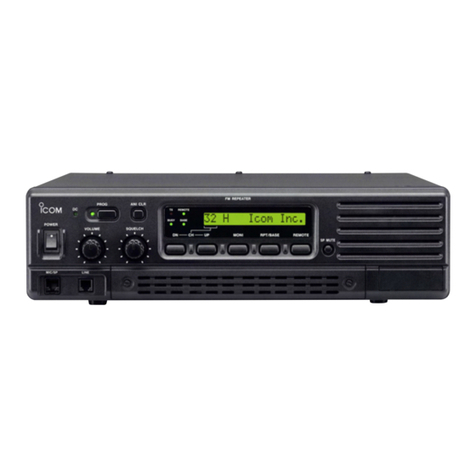
Icom
Icom FR3000 02 User manual
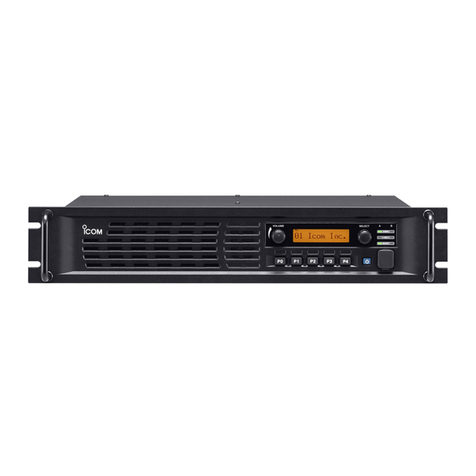
Icom
Icom iC-FR5000 User manual
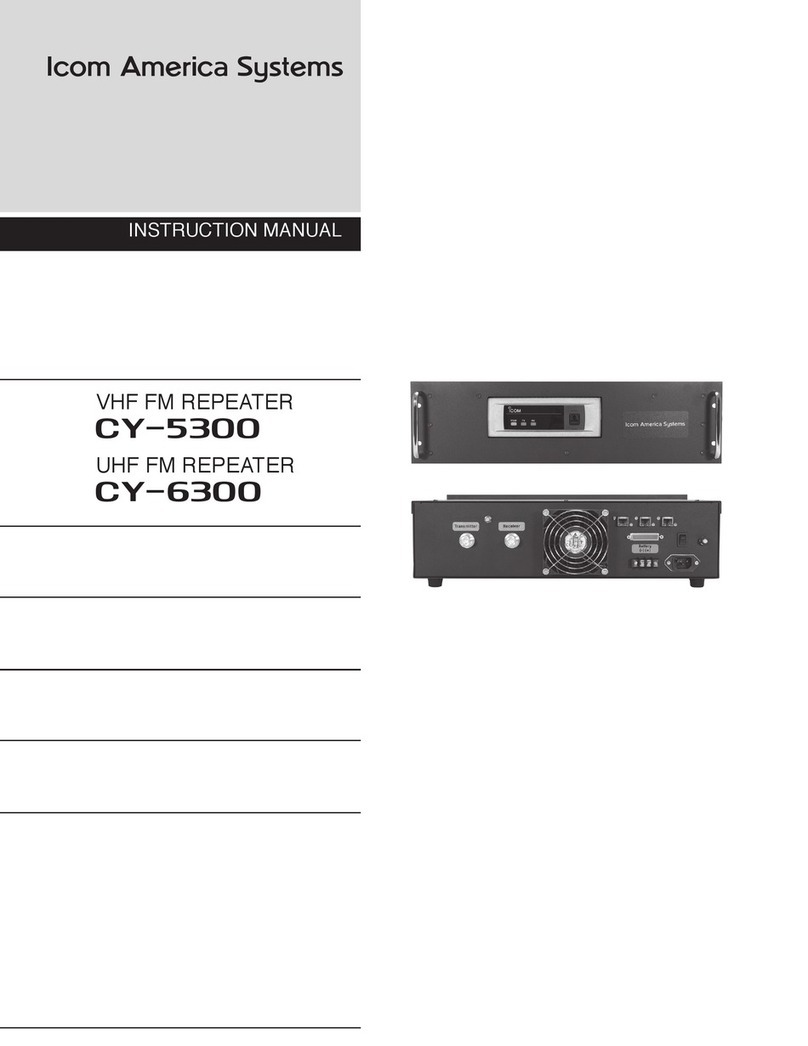
Icom
Icom CY-5300 User manual
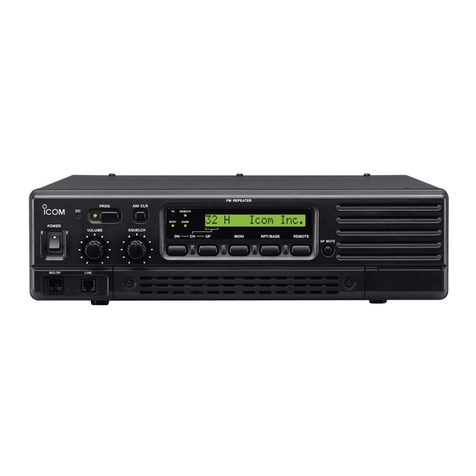
Icom
Icom IC-FR3000 Series User manual

Icom
Icom IC-RP4520 User manual

Icom
Icom UR-FR5000 User manual
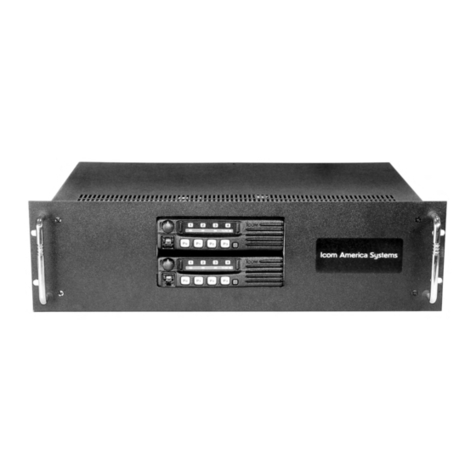
Icom
Icom CY-F121S User manual
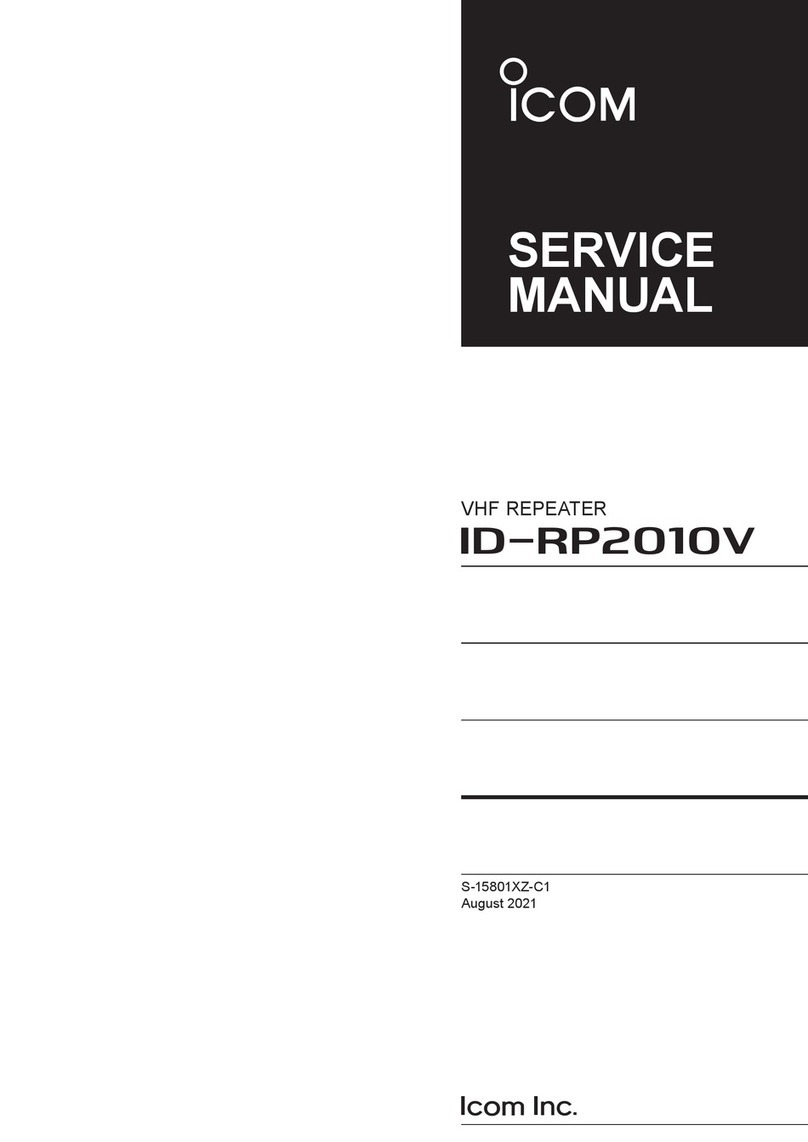
Icom
Icom ID-RP2010V User manual
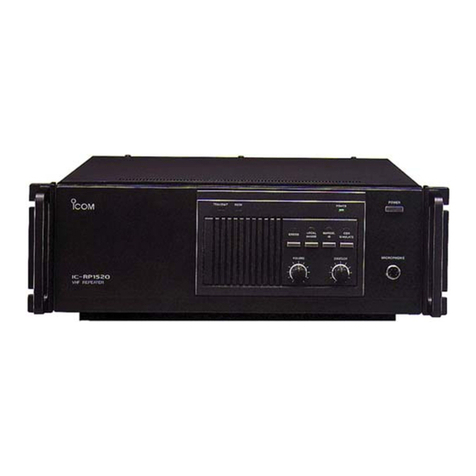
Icom
Icom IC-RP1520 User manual
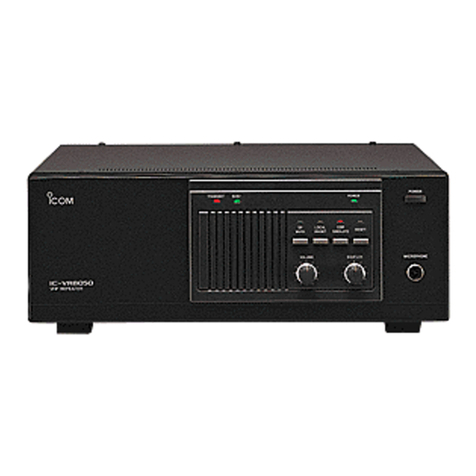
Icom
Icom IC-UR8050 User manual
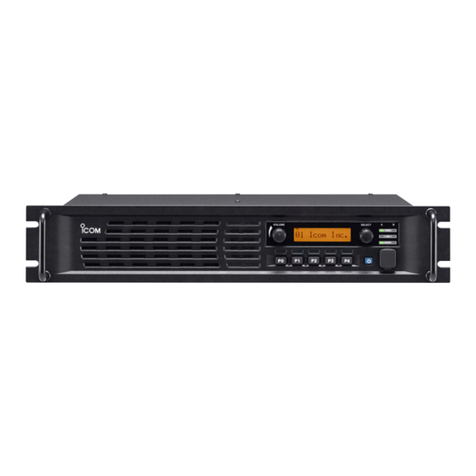
Icom
Icom iC-FR5000 User manual

Icom
Icom id- rp2 User manual
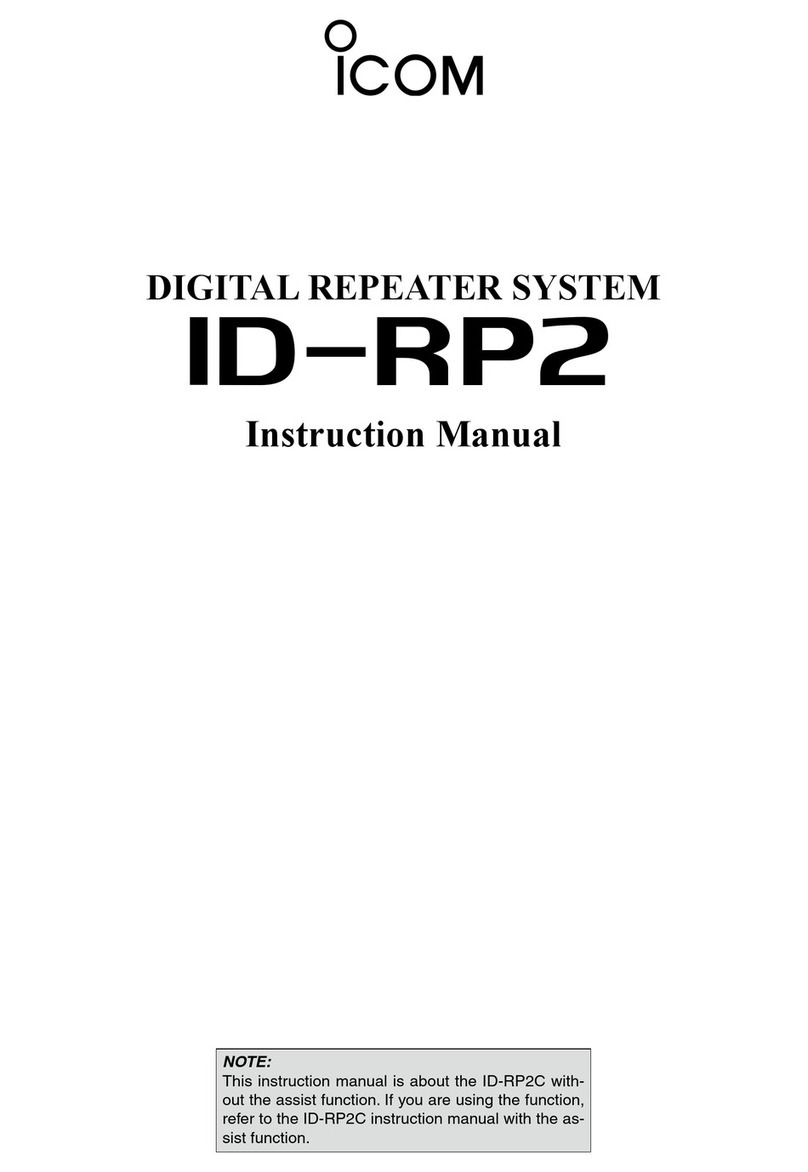
Icom
Icom ID-RP2C User manual
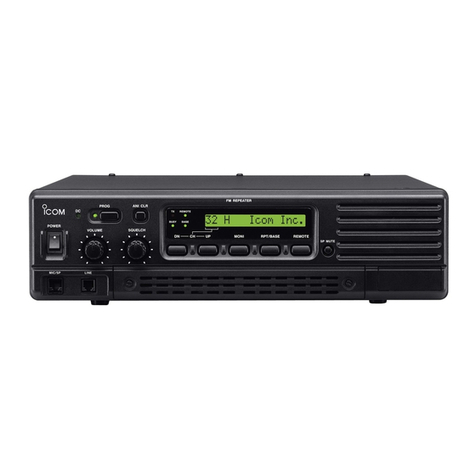
Icom
Icom IC-FR4000 Series User manual
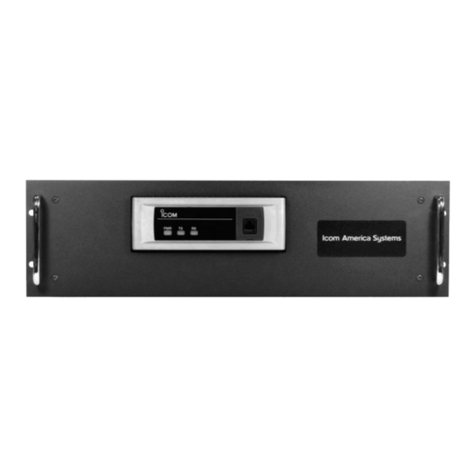
Icom
Icom CY 6000 User manual

Icom
Icom iC-FR5000 Installation and operating instructions

Icom
Icom IC-RP1520 User manual

Icom
Icom IC-FR4000 Series User manual
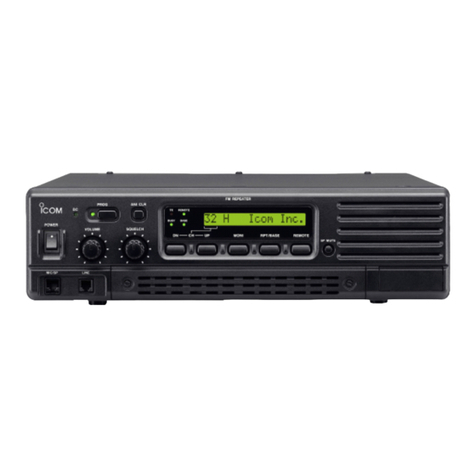
Icom
Icom FR3000 User manual
